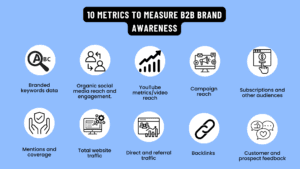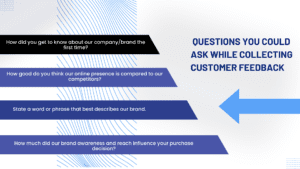This article was originally published in the Elevate Your Marketing newsletter and has been repurposed and republished here with the author’s permission. Here is the link to the original article.
B2B marketing leaders and founders are often puzzled by the measurement of their brand marketing efforts. Modern-day marketers are pressurized to show the ROI of all the brand awareness activities they do. As many think, brand awareness and reach is not immeasurable. There are specific KPIs (Key Performance Indicators) and metrics you can measure to assess the effectiveness of your brand marketing efforts.
In this article, let us discuss the 10 key metrics you need to analyze to understand whether your brand marketing campaigns are delivering the desired results.
Setting the context for B2B brand awareness metrics
All the 10 metrics I have listed in this article are not individual numbers, but rather a category or group of metrics that can be measured to evaluate your brand strength. Under each, I have also mentioned the individual metrics or values you need to measure.
That said, let us dive right in!
10 metrics to measure B2B brand awareness
The 10 types of metrics you need to measure for assessing the brand awareness and reach of your B2B business are:

10 metrics to measure B2B brand awareness
- Branded keywords data.
- Organic social media reach and engagement.
- YouTube metrics/video reach.
- Campaign reach.
- Subscriptions and other audiences.
- Mentions and coverage.
- Total website traffic.
- Direct and referral traffic.
- Backlinks.
- Customer and prospect feedback.
Let us now look at each of them in detail.
1. Branded keywords data
The number of times your brand name is searched for will give you an indication of your company’s reach and awareness. You can find this data in multiple ways as given below:
- Log into Google Search Console and look for the number of impressions and clicks your brand-related keywords get.
- Use a keyword tool like Ahrefs to see the amount of traffic branded keywords are bringing to your website. You could also track the search volume of these keywords.
- Use a traffic analysis tool like Similarweb.com to see the percentage of branded vs non-branded keyword searches. This will give you a sense of how widely your brand name is searched for.
One thing to note here is that, while looking for brand keywords data, make sure to include all the possible variations. For instance, if your company name is ‘Congur’, you need to consider phrases like ‘Congur office’, ‘Congur location’, ‘Congur address’, etc., as well while consolidating the keyword data (assuming that you are getting traffic to the website for these phrases). If searches using your leaders’ names are also generating some traffic (which happens if they are popular), you could count them in as well.
2. Organic social media reach and engagement
The reach your content has across all the social media platforms is a good measure of how popular your brand is. Though the metrics will vary slightly depending on the platform, more or less you need to measure reach and engagement using the following values:
- Number of impressions/views.
- Number of likes, comments, shares, etc.
- Number of followers.
You could also have metrics specific to different platforms. For instance, you might want to measure custom button clicks on LinkedIn. Similarly, retweets on X are something that you don’t want to miss out on measuring.
Related: How To Create Content For LinkedIn Organic Marketing [With 10+ Examples And 5 Templates]
3. YouTube metrics/video reach for measuring B2B brand awareness
Most businesses use YouTube as the primary platform to host and distribute video content. However, if you are using any other platform like Vimeo, or even LinkedIn as the primary distribution channel for videos, you need to measure relevant metrics on those mediums.
For now, let us list down the metrics for YouTube (and you can find corresponding metrics on any other platform you might be using). Below are the metrics you can monitor at a channel level:
- Video views
- Watch time
- Subscribers
- Impressions
- Impressions click-through rate
- Average view duration
- Returning viewers and unique viewers
In addition to viewing numbers at a channel level, you can dig deep into the analytics of every single video on YouTube. You would be able to see most of the above metrics at the video level as well. One notable data you could find here is the traffic source of your video. Some of the traffic sources on YouTube include YouTube suggestions, notifications, channel pages, external, etc.
Also read:
7 B2B Video Marketing Hacks You Should Try
Metrics you should measure to assess the effectiveness of your B2B marketing efforts
4. Campaign reach
The reach of your paid campaigns is an indication of how many times your content has been consumed, and accordingly how many times your brand has been ‘seen’.
In most of the platforms you use for paid campaigns (say Google ads, LinkedIn ads, Facebook ads, etc.), you can use ad impressions/views and clicks as the metrics to measure brand awareness or reach. While impressions/views will tell you how many times your content has been seen, clicks will give you data on how many people your campaigns have been able to attract to your website.
5. Subscriptions and other audiences
These refer to any kind of subscriptions you have for your company’s content across platforms (please note that this is different from paid subscriptions of your product if you are in the B2B SaaS space or are selling any kind of subscription-based product). Some examples include:
- Newsletters (either a custom email newsletter or on a platform like Substack or LinkedIn).
- Blog subscriptions.
- Communities (communities that you own and run).
By using subscriptions, you are mostly trying to educate your audience. The number of people you are able to reach with these would tell you how many people are being influenced or positively impacted by your content.
In addition to merely counting the number of subscribers, you can make more sense of this data by measuring metrics like delivery rate, open rate, click rate (in the case of email-based subscriptions), number of new subscribers added during a period, traffic from subscriptions, etc.
6. Mentions and coverage
Mentions and coverage refer to nothing but shoutouts of your brand’s name across social media platforms, press coverages, conferences, online events, etc.
To measure mentions and coverage on social media platforms, you can use a social media analytics tool like Brands24 or Mention. The number of press coverages can also be measured automatically to some extent by looking at the data you get from the PR distribution site you use (like prweb.com or prnewswire.com). As long as the website has a self-serve analytics module, you should be able to get the data.
Some of the other items like mentions in conferences, online events, podcasts, etc., will have to be manually tracked.
7. Total website traffic as a measure of B2B brand awareness
This might be a little tricky. You could argue that the absolute value of a website’s traffic cannot be taken as a benchmark since this number could vary across industries. To tackle this issue, some marketers adopt the methodology of comparing their company’s traffic to its top competitors.
Whatever method you are following, given that the website forms a company’s ‘face’, the number of eyeballs you get on it is a good measure of how far your brand has reached. Some of the metrics you can measure here are:
- Users
- Sessions
- Views
- New users vs returning users
- Impressions (obtained from Google Search Console)
- Clicks (obtained from Google Search Console)
- Click-through rate (obtained from Google Search Console)
8. Direct and referral traffic
While direct traffic is a measure of how many people are landing on your website without a ‘nudge’ or direct campaigns/outreach, referral traffic will give you an idea of how many users or pageviews external sources have generated for your website.
These data points can be obtained from Google Analytics. You can drill down further to see:
- Which pages have the highest direct and referral traffic.
- Which sources contribute to the highest amount of referral traffic.
- How have direct and referral traffic changed over a period.
9. Backlinks
Backlinks are one of the most important contributing factors to the SEO success of a website. At the same time, they also mean that many people/websites have willingly linked to your website. This tells you the breadth of your brand’s reach in terms of the external websites that have given you credit for your content.
This can be measured using metrics like:
- Total number of backlinks.
- Number of referring domains.
- Region-wise distribution of the referring domains.
You can obtain these data points from an SEO tool like Ahrefs.
Related: Getting Started With SEO-led Content In 3 Days
10. Customer and prospect feedback
Customer surveys are one of the most popular techniques used to understand the recall and recognition of your brand among your existing as well as potential customers. You can build the survey questionnaire with a mix of multiple-choice and open-ended questions to get the right insights about your brand.
Some of the questions you could ask while collecting customer feedback are:

Questions you could ask while collecting customer feedback
- How did you get to know about our company/brand the first time?
- How good do you think our online presence is compared to our competitors?
- State a word or phrase that best describes our brand.
- How much did our brand awareness and reach influence your purchase decision?
Here, the objective is not to measure brand awareness purely in quantitative terms, but rather to understand the nature and quality of the reach you have developed over time.
You could also do a similar exercise with your prospects where you can focus on the brand discovery phase (such as whether the prospects know your brand, how they found out about you, etc.) rather than the brand affinity or loyalty phase.
Also read: How To Collect Customer Feedback And Integrate It Into Marketing?
Skalegrow – B2B brand marketing agency
With marketing getting tougher and tougher, every wrong foot you make might hamper your growth. What you need is the right guidance and a helping hand. This is where Skalegrow can make a sea of difference.
Skalegrow helps IT, tech, SaaS, and embedded systems companies leverage new-age marketing tactics to grow their business. Check out the below intro video to learn more about what Skalegrow brings to the table:
Brand marketing is one of the areas we specialize in. Whether it’s in the form of creating great content, crafting a unique positioning, or ensuring a consistent brand identity, we can help. Write to us at info@skalegrow.com for more details.
About the author

Naseef KPO is the Founder and CEO of Skalegrow. He comes with rich experience across multiple areas of B2B marketing including content marketing, demand generation, SEO, account-based marketing, marketing analytics, revenue attribution, marketing technology, etc. He writes thought-provoking and relevant articles on The Skalegrow Blog and his weekly LinkedIn newsletter Elevate Your Marketing.
Prior to starting Skalegrow, Naseef led large marketing teams in multi-million dollar B2B organizations where he made significant contributions to the topline growth of the business. He has also appeared on numerous podcasts where he shared his thoughts on trending marketing topics such as the application of AI in marketing, startup marketing, ABM, and B2B content marketing, just to name a few. Being the founder of Skalegrow, he is currently focusing on helping its clients stay ahead of their competition by using innovative yet practical marketing tactics.
You can connect with Naseef KPO on LinkedIn.


